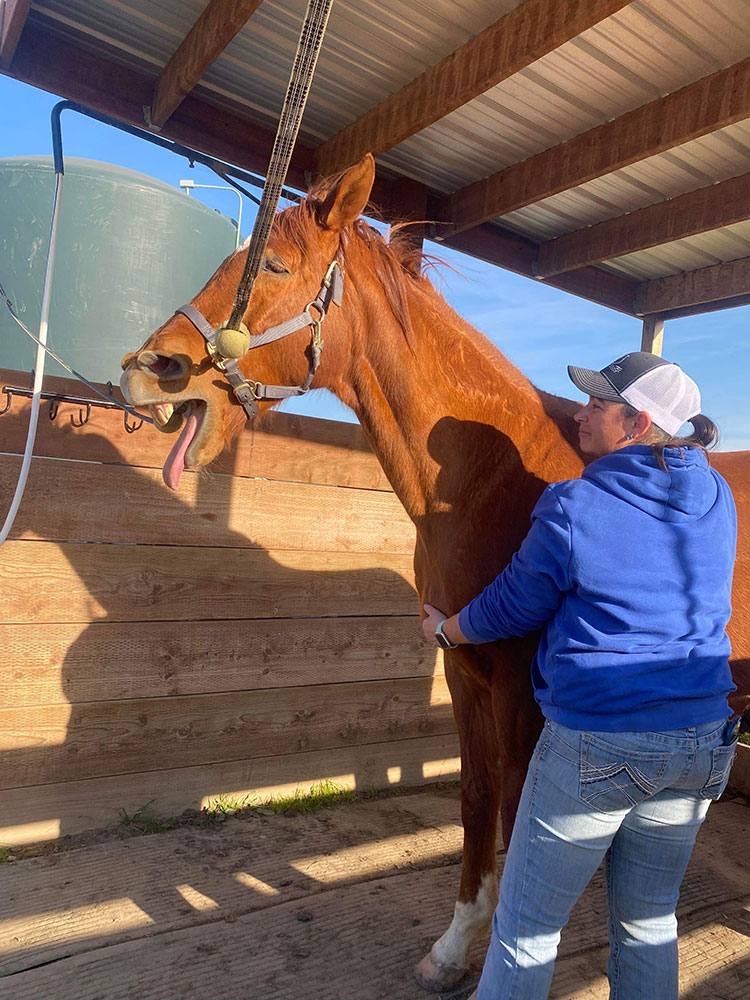A Comprehensive Guide to Anatomy, Dysfunction, and Support of the Equine Thoracic Sling
Introduction
When you look at a horse’s front end, it’s easy to forget one significant difference between them and us: they do not have a collarbone. So how does a 1,000-pound animal hold its chest up 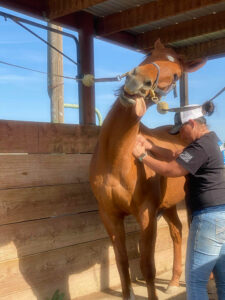 between its front legs? The answer lies in the thoracic sling — a system of muscles that suspends the horse’s body between the shoulders, absorbing shock, maintaining posture, and allowing for smooth, balanced movement.
between its front legs? The answer lies in the thoracic sling — a system of muscles that suspends the horse’s body between the shoulders, absorbing shock, maintaining posture, and allowing for smooth, balanced movement.
Anatomy of the Thoracic Sling
The thoracic sling is a unique structure in the horse’s body, made up of several key muscles that connect the scapula (shoulder blade) to the trunk rather than to a bone structure like in humans. These muscles work together to suspend the chest and support the horse’s movement.
· Serratus ventralis (cervical and thoracic portions): The primary “sling straps,” supporting the trunk and allowing lift through the withers.
· Pectoral muscles (superficial and deep): Stabilize the limb and aid in adduction (drawing the leg inward).
· Subclavius: Found in some horses, it works alongside the pectorals to help draw the limb back and in.
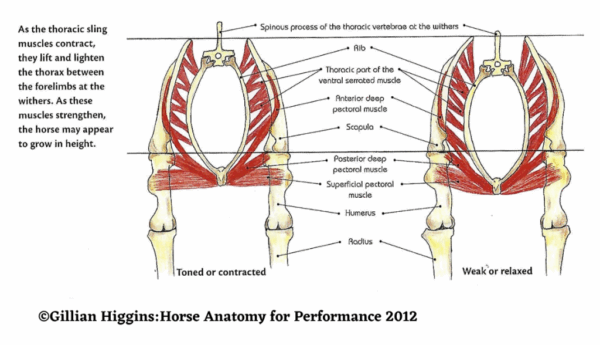 · Trapezius and rhomboids: Support scapular movement and assist in lifting the withers and neck.
· Trapezius and rhomboids: Support scapular movement and assist in lifting the withers and neck.
Together, these muscles act like a hammock, holding the body off the ground while still allowing flexibility and movement.
Signs of Thoracic Sling Dysfunction
When the sling is not working properly — due to weakness, tension, poor saddle fit, compensation, or repetitive stress — it shows up in the horse’s posture and performance. Recognizing these signs early can be key to helping your horse move comfortably and efficiently.
· A dropped or “hollow” appearance behind the withers
· Heavy contact on the forehand or difficulty lifting the shoulders
· Shortened front-end stride or toe-first landing
· Uneven front-end loading or early front-foot soreness
· Tightness or tenderness through the chest, girth area, or behind the scapula
· Difficulty developing topline even with consistent work
You might also notice that the horse feels downhill, resistant to collection, or struggles to maintain self-carriage for prolonged periods.
Supporting and Strengthening the Thoracic Sling
The goal is not just to release tightness — it’s to restore balance and stability so the horse can carry themselves correctly. Here are a few ways to do that:
1. Bodywork and Massage: Regular soft tissue work, especially massage, can release restrictions in the pectorals, trapezius, and serratus ventralis, allowing for freer movement and better symmetry. Massage helps by increasing blood flow, reducing muscle tension, and encouraging relaxation throughout the thoracic sling. Targeted massage can also break up adhesions, support muscle recovery after exercise, and improve range of motion in the shoulders and chest. Horses receiving regular massage often show greater lift and flexibility through the withers, improved stride length, and better overall comfort.
2. Correct Riding and Conditioning: Encourage lifting through the base of the neck and engaging the core. Hill work, transitions, and backing exercises help build sling strength naturally.
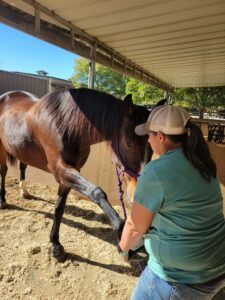 3. Stretching and Mobility Work: Gentle stretches for the shoulders and chest can improve range of motion and reset muscle balance.
3. Stretching and Mobility Work: Gentle stretches for the shoulders and chest can improve range of motion and reset muscle balance.
4. Saddle Fit and Posture Checks: Even the strongest sling can’t function well under uneven pressure or poor balance from the rider.
5. Consistency Over Intensity: These muscles respond best to regular, low-stress engagement rather than heavy, isolated work.
Bringing It All Together
The thoracic sling is the silent supporter of everything the front end does — from lifting over jumps to sliding stops to simply standing square. When it is balanced, the horse moves freely and lightly. When it is compromised, everything else must work harder to compensate.
Through intentional conditioning, thoughtful bodywork, and the therapeutic benefits of massage, you can help your horse develop the kind of strength that lasts — not just in the hind end, but through the core and shoulders where true balance begins.
Book Your Horse’s Next Session
SLBH Equine Bodywork offers professional equine massage and bodywork services tailored to your horse’s unique needs, focusing on 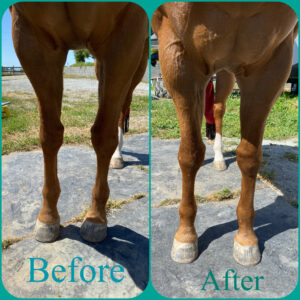 restoring balance, comfort, and performance. To schedule an appointment or learn more about available services, please contact SLBH Equine Bodywork via www.slbhequinebodywork.com or phone. Experience the benefits of expert bodywork and help your horse move and feel their best.
restoring balance, comfort, and performance. To schedule an appointment or learn more about available services, please contact SLBH Equine Bodywork via www.slbhequinebodywork.com or phone. Experience the benefits of expert bodywork and help your horse move and feel their best.

